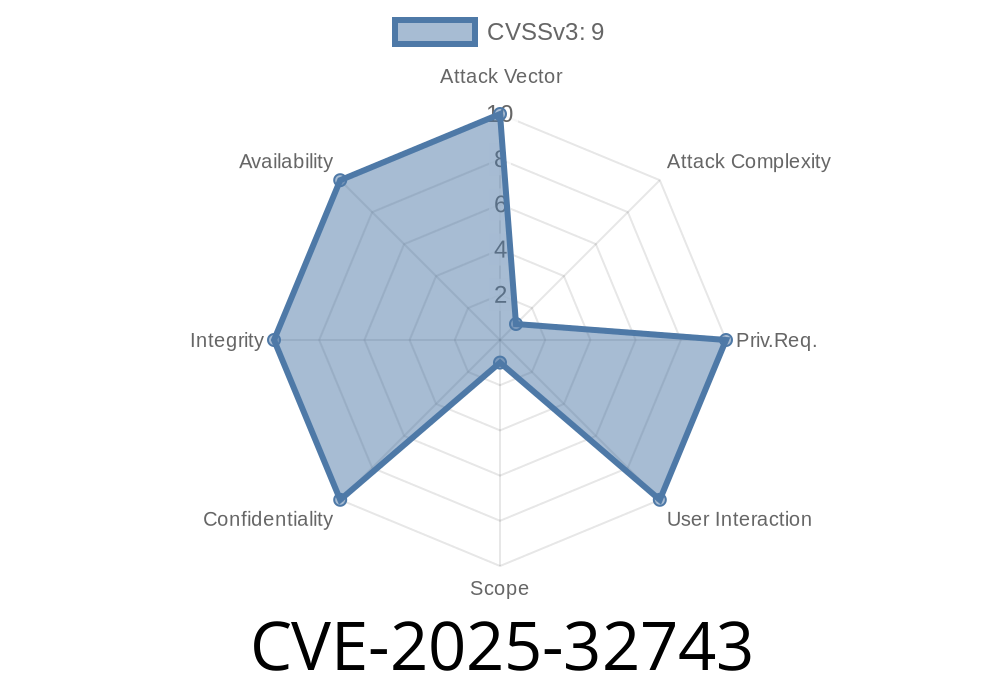CVE-2025-32743 is a fresh vulnerability affecting ConnMan, the popular connection manager used on Linux-based systems and embedded devices. This bug can be abused to crash the system or, with a bit more effort, run malicious code—all thanks to mishandled DNS responses. In this post, I’ll walk you through the vulnerability, show code snippets highlighting the weakness, and explain how an exploit might be built around this bug.
What is ConnMan?
ConnMan (Connection Manager) is an internet connection manager for embedded devices using Linux. It manages network connections, including wifi, ethernet, cellular, and even VPNs.
- GitHub: https://github.com/NetworkManager/connman
- Homepage: https://01.org/connman
Where’s the Bug?
The bug lives in dnsproxy.c, inside the ns_resolv() function. When ConnMan receives a DNS response with the Truncated (TC) bit set, the process tries to look up a string from the DNS query. But if this lookup fails, it doesn’t check if the returned pointer is NULL or an empty string before using it.
This is dangerous. When memcpy() and length calculations run using that NULL or empty value, ConnMan can crash (DoS), or worse—an attacker could craft a payload to trigger controlled memory corruptions, leading to arbitrary code execution.
Here is a simplified version of the vulnerable code pattern, inspired by ConnMan 1.44
void ns_resolv(unsigned char *packet, int len) {
char *lookup = dns_lookup(packet, len);
// ...skip some validation...
// (!!!) Vulnerable: No check if lookup is NULL or empty
size_t name_len = strlen(lookup);
memcpy(dstbuff, lookup, name_len);
// ...rest of function...
}
If lookup is NULL, strlen(lookup) will crash. If it’s an empty string (""), size is zero, which will likely be harmless at this point, but downstream code might rely on an expected name. Worse, if the destination pointer (dstbuff) calculations are also not validated, you get an exploitable situation.
How Attackers Can Use This
The exploit is possible when an attacker can send a _malicious_ DNS response back to a vulnerable ConnMan DNS proxy. Here’s how an attack might go:
Attacker sends a DNS query, expecting ConnMan to handle it.
2. Attacker’s DNS server replies with a response with the "TC" (Truncated) bit set and a crafted answer that will trigger ConnMan’s parser bug.
3. When ConnMan tries to process the broken/missing lookup string, memory calculations go haywire.
Exploit #1: Denial of Service
Just make dns_lookup() return NULL by crafting the DNS response with the right values. ConnMan crashes on strlen(NULL).
Exploit #2: Arbitrary Code Execution
If you have control over other DNS response fields, you may be able to set up memory so that the bad memcpy() writes attacker-controlled data to a sensitive location. This is harder, but possible with buffer overflows if the code doesn’t validate sizes or pointers.
TC bit set in the DNS header (x020)
- Omit or mangle the name/query field so dns_lookup() fails
- Optionally, manipulate further fields to exploit any buffer/length errors beyond DoS
*A real-world exploit would require reversible engineering of the exact DNS parser logic in ConnMan and possibly specialized tools to craft custom DNS packets.*
Sample Scapy Python Code Skeleton
from scapy.all import *
dns_response = (
DNS(
id=x1337,
qr=1, # This is a response
aa=1,
tc=1, # Truncated bit set
rd=1,
ra=1,
qdcount=1,
ancount=, # No answer, triggers faulty lookup
qd=DNSQR(qname='example.com', qtype='A')
)
)
send(IP(dst="<TARGET>")/UDP(sport=53, dport=<CONNMAN_LISTENING_PORT>)/dns_response)
The specifics depend on the deployment and how the function is triggered. The key is setting tc=1 and creating a malformed or missing answer section.
Real-World Risk
- Embedded devices and IoT running Linux + ConnMan are at risk—routers, smart gadgets, and appliances.
Is There a Fix?
- The bug has been acknowledged and discussed in security advisories (check for updates).
- Watch the ConnMan mailing list and GitHub issues for patches or mitigation.
- Temporary workaround: Firewall off untrusted DNS, disable ConnMan’s DNS proxy feature if not needed.
References
- ConnMan Source
- CVE-2025-32743 MITRE record
- ConnMan Security Issues
- ConnMan Project Home
Summary
CVE-2025-32743 is a real, actionable threat for any system using ConnMan up to version 1.44. Attackers can crash your device, or possibly run code, just by sending a malicious DNS response. Patch as soon as possible, and limit exposure to untrusted networks in the meantime.
If you’re a sysadmin, patch ConnMan. If you’re a security engineer: investigate DNS traffic, scan for malformed packets, and monitor for unexpected crashes in ConnMan.
Timeline
Published on: 04/10/2025 14:15:29 UTC
Last modified on: 04/11/2025 15:39:52 UTC
